Introduction:
One of the basic attributes of any cementitious material, be it mortar or concrete, is its workability or "consistence", that is, how easy it is to push one way, pull the other, and float to a smooth level. Workability is largely determined by wetness, by how wet is the mortar or concrete. This is referred to as "Slump".
In essence, the wetter the concrete, the higher the slump. Mortars or concretes with a high water content are said to have a high slump, while those with a low water content have a low slump. Although slump is often seen as an indication of water content, it is more legitimately interpreted as a measure of consistence.
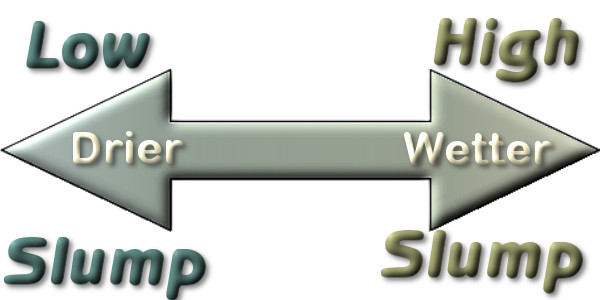
Slump Test
The slump of a concrete (or mortar) is determined via a fairly simple test using incredibly simple equipment, comprising a 300mm high hollow steel cone with handles, a steel tamping rod, a steel base plate and a tape measure. This testing apparatus is readily available from contractor's tool suppliers, although all ready-mix suppliers will test the slump of their delivered product on request.
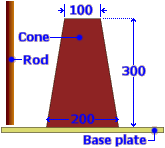
The procedure is as follows:
-
The cone is positioned on the base plate with the smaller aperture uppermost
-
Freshly supplied concrete is poured into the cone to approximately one-quarter of its depth (75mm)
-
The concrete is tamped using 25 strokes of the steel rod
-
Further concrete is added to fill the cone to approximately one-half depth (ie: another 75mm of concrete)
-
Again, the concrete is tamped using 25 strokes of the rod
-
More concrete is added to bring up the level to three-quarter depth (another 75mm)
-
25 strokes with the rod are used to tamp down the concrete
-
The cone is filled to the top and tamped using a final 25 strokes with the steel rod
-
A final trowelful or two of concrete is added to bring it level with the top of the cone
-
The cone is carefully lifted upwards, clear of the concrete and is placed, upside-down next to the concrete
-
After a minute or so, the unrestrained concrete will settle downwards or "slump" due to gravity
-
The steel rod (or other suitable straightedge) is used to span the inverted cone and towards the slumped concrete
-
The height difference between the steel cone and the slumped concrete is measured
-
This difference, measure to the nearest 10 millimetres, is "The Slump"
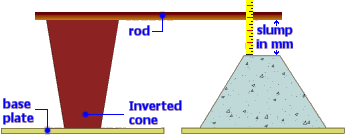
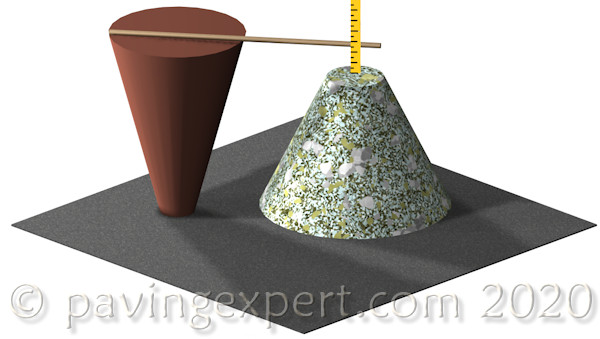
Slump (consistence) class
Following the adoption of the new European Standard for Concrete in 2003 (BS8500), consistence (workability or slump) is now specified as being of a particular class. There are five classes, labelled S1 to S5, with each class spanning a range of slump values. These area shown in Table 1 below:
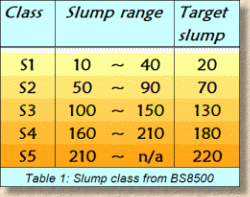
Each class has a target slump, but there is some 'leeway'. The table opposite is a highly simplified version of the full table which gives values for target slump according to the point in the discharge operation that the samples are taken. However, it should be adequate for general specification purposes associated with paving projects.
As a rough guide to usage, S1 concretes are most likely to be used for kerb and pipework bedding; S2 for simple strip footings and cast in-situ hard-standing slabs; S3 would be used for trench-filled foundations where a high flowability is required. S4 and S5 are likely to be used in specialist applications and advice from a suitably experienced concrete technologist should be sought before specifying concrete in these classes.
When using concrete with high slump values (>150mm [S4 or S5]) there is a risk that the aggregates and cement will settle out. or segregate This is usually countered by the use of various additives to ensure the concrete remains workable and structurally competent. However, a different test, known as the flow table test, is normally used to assess the workability of high slump concretes.
Ready-mix concrete is (or should be) delivered to site with a consistency within the specified slump class and close to the target slump. Additional water mixed in to the concrete prior to discharge can only be added under written instruction from the contractor or the contractor's agent, as additional water will alter the w/c ratio and may alter the slump class. The ready-mix supplier will require a signature authorising the additional water and this action may affect their liability for the perfomance of the concrete.
Site Terms:
Concrete and mortars for paving projects
Throughout this website, mortars and concretes are mentioned as being used for bedding or jointing. Following on from the explanation regarding slump class above, it should be apparent that there are three commonly used slump classes, S1, S2 and S3.
As these slump classes are relatively new to the language of a typical building site, descriptive names are often used to indicate the approximate consistence of a particular concrete or mortar mix. These are shown below:
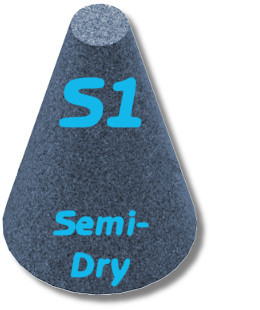
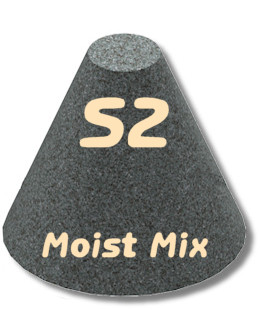

So: concrete with a S1 consistence is often referred to as "semi-dry"; S2 is probably the most useful and most commonly specified consistence and is referred to as a "moist mix", while S3 would be known as a "wet mix". Bricklaying mortar is often a S3 consistence, although that used for laying stonework is usually somewhat stiffer, possibly S2.
